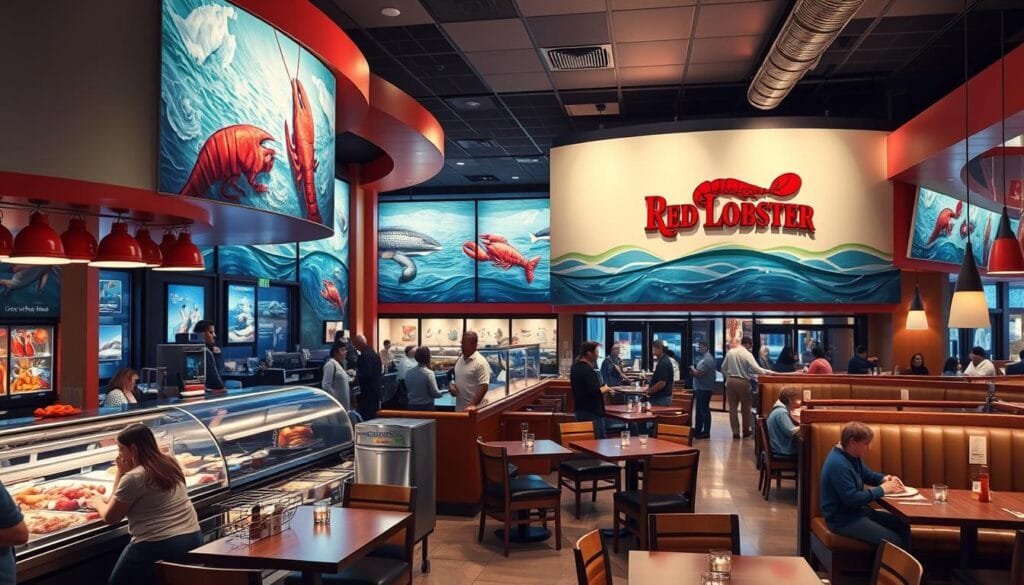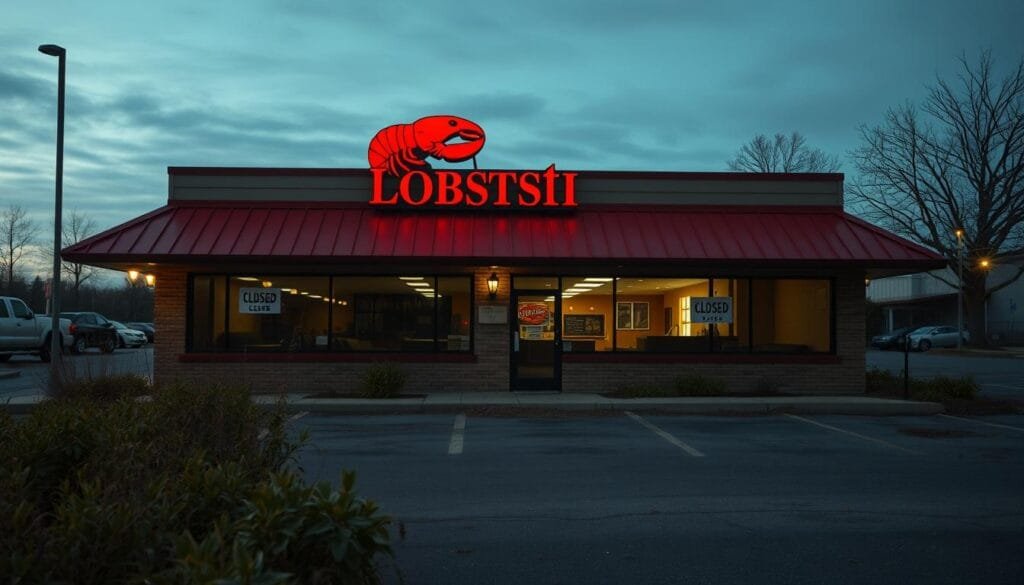The famous seafood chain Red Lobster has hit hard times, leading to a Chapter 11 bankruptcy filing. But there’s a ray of hope. A judge has okayed a plan to reorganize the business.
During the legal process, Red Lobster’s large debts and shutting down of many locations were clear. This made people wonder what the future holds for the seafood chain. As we look closer, let’s discover how Red Lobster plans to bounce back after bankruptcy. They aim to make their brand strong again and regain the trust of their customers.
Key Takeaways
- A federal judge has given the go-ahead for Red Lobster’s restructuring plan post its Chapter 11 bankruptcy.
- The seafood chain faced significant location closures and financial hurdles leading to its recent bankruptcy filing.
- Strategic moves are now in place to address the debt and operational challenges it faces.
- Efforts are being made by Red Lobster to reinvigorate its brand post-bankruptcy for a sustainable seafood chain future.
- Insights into the company’s next steps and prospects are pivotal for understanding its potential revival.
- The role of Fortress Investment Group and leadership changes signal a new direction for Red Lobster.
The Path to Red Lobster’s Bankruptcy
Red Lobster’s path to bankruptcy is a story of how big problems can grow from small mistakes. It was once a popular place, but then it faced huge debts and bad choices by its leaders. These issues led to closing many of its restaurants and losing a lot of money. This piece explores how such troubles came to be, especially focusing on promotions that didn’t work out well.
Red Lobster’s Chapter 11 Filing
Red Lobster had to file for Chapter 11 bankruptcy to fix its money troubles. This decision was needed because of the impact of bad leadership and growing debt. In 2023, they saw losses of $76 million, showing how important it was to reorganize their finances.
The Causes: Debt, Location Closures, and Management Missteps
The road to Red Lobster’s bankruptcy was filled with different problems. Big debts and poor choices by management were key issues. The COVID-19 pandemic made things even worse, leading them to close some of their restaurants. They went from 578 to 544 locations in America and Canada. This was a last-ditch effort to save money along with the Chapter 11 filing.
Impact of the $20 All-You-Can-Eat Shrimp Promotion
The $20 all-you-can-eat shrimp deal was a big mistake for Red Lobster. Trying to attract more people, this offer caused them to lose about $11 million in just one quarter. They didn’t balance the cost of the food with how much people ate, which led to huge losses. These losses were too much for their normal earnings to cover.
Looking at previous mistakes shows a pattern. Like in 2003, the “Endless Crab” deal also led to big losses because of high crab prices.
Looking back at decisions like the shrimp deal offers lessons for Red Lobster as it works through bankruptcy. The goal now is to rebuild the brand and avoid more money problems with better planning and reorganization.
Restructuring Plan and New Ownership
RL Investor Holdings LLC has recently taken over Red Lobster. This marks a big change for the restaurant chain. The new ownership is not only about changing hands. It also starts a major makeover with important investments in the seafood industry.
Acquisition by RL Investor Holdings LLC
Red Lobster was bought by RL Investor Holdings LLC. This group is linked with Fortress Investment Group, TCW Private Credit, and Blue Torch. The deal was worth $375 million. It brought fresh investment strategies to revive Red Lobster. The brand will see better operational efficiency and customer service as a result.
Introduction of Damola Adamolekun as CEO
The appointment of Damola Adamolekun as CEO is key to Red Lobster’s revival. He has shown strong leadership at P.F. Chang’s before. Adamolekun brings new strategies to boost Red Lobster during its turnaround. His aim is a profitable future for the brand.
Investment Plan and Future Prospects
Red Lobster is rejuvenating with over $60 million in investments. This funding is vital for their long-term strategy. It aims to tap into the chain’s longstanding place in the market. Plus, it upholds the commitment to high-quality, sustainably sourced seafood. This ensures Red Lobster stays popular among seafood lovers.
| Statistic | Detail |
|---|---|
| Total Investment | $60 million plus for restructuring and improvements |
| Acquisition Cost | $375 million by RL Investor Holdings LLC |
| Locations | 544 in USA and Canada |
| New Leadership | Damola Adamolekun |
| Future Strategy | Focus on financial health and operational strengthening |
With Damola Adamolekun leading and new funds, Red Lobster aims for a strong comeback. They are ready to face the competitive restaurant industry from a new, stronger position.

Store Closures and Financial Struggles
Red Lobster, once a thriving chain, faces serious financial troubles. This has led to many North American locations closing down. Industry experts and customers are closely watching these developments.

Location Shutdowns Across the US and Canada
Close to 100 of the 650 Red Lobster restaurants have shut down for good. This major change affects 21 states, including places like Florida, New York, and California. The large number of closures shows Red Lobster’s big challenges in today’s market.
Sale of Equipment and John Oliver’s Initiative
After these closures, there was a big auction for Red Lobster’s gear, including kitchen tools and memorabilia. This auction got attention from John Oliver, a famous comedian. He bought some items and made a funny segment on his show about Red Lobster.
Below are some key facts that show Red Lobster’s rough patch:
| State | Number of Closures |
|---|---|
| Florida | 17 |
| New York | 11 |
| Texas | 10 |
| California | 8 |
As updates come in, it’s clear that Red Lobster must change its strategy. How the community reacts and how the brand adapts will shape its future.
Is Red Lobster Going Out of Business?
In the whirlwind of industry challenges and upcoming restaurant closures, questions arise about Red Lobster’s status. The brand has seen ups and downs in its long history. With Fortress Investment Group’s help, big changes may be coming for this iconic brand.
Red Lobster is working to reduce its size by ending some leases and cutting down the company size. This move is to make operations leaner and help it make profits in the competitive restaurant market.
Plans for Closing Additional Restaurants
This August, Red Lobster plans to shut down another 23 locations. This follows over 100 closures done earlier this year. By the end of this, about 500 restaurants will remain, a big drop from before. For more details click here.
The Role of Fortress Investment Group
Fortress Investment Group is giving Red Lobster a crucial $100 million boost. This money is vital for keeping the business stable. It also lets Red Lobster plan its future under new ownership. This help is part of bigger acquisition deals that change how dining businesses adjust to new financial and customer demands.
A Glimpse into Red Lobster’s Historical Expansion and Struggles
Since its start in 1968, Red Lobster has had a story of growth and challenges. It went from a small place in Florida to a big name in affordable seafood across the U.S. The Red Lobster history is a tale of innovation and facing tough times.

In recent years, changing markets and the COVID-19 pandemic have pushed Red Lobster to focus on being efficient and setting prices smartly to stay competitive. The company hopes that with good financing and downsizing, it can navigate through hard times. The goal is a future where the brand can thrive.
| Year | Key Events | Impact |
|---|---|---|
| 1968 | Establishment of Red Lobster | Initiated nationwide affordable seafood trend |
| 1970 – 2014 | Ownership transitions through General Mills to Darden Restaurants | Expansion and solidification of market presence |
| 2014 – Present | Sale to private equity and investment by Thai Union Group | Strategic realignments and efforts to revamp branding |
Red Lobster’s future involves dealing with employee reductions, strategic closures, and adopting new business strategies. With support like Fortress Investment Group, the path ahead is cautiously optimistic. It will require careful planning.
Conclusion
Looking closely at Red Lobster, we see their strong efforts to recover. They’re now navigating through tough times in the hospitality field. The future of Red Lobster is still up in the air, drawing much attention and guesses. About two dozen more locations will close due to bankruptcy steps. This is part of Red Lobster’s plan to make their operation more streamlined. They had to shut down more places earlier, bringing their total from 650 to around 500.
Despite facing a big $11 million loss from a promotion and dealing with Thai Union’s bankruptcy, Red Lobster hasn’t lost hope. They got a $100 million loan from Fortress Credit to help them stand strong again. This money, along with a plan to become more efficient, shows their commitment to bouncing back. The aim is to shine again in the industry outlook.
Red Lobster’s journey shows the tough challenges and big changes in the market, something other big names like Oberweis Dairy and Cracker Barrel also face. How well Red Lobster can handle its makeover will decide its future. Fans of seafood and Red Lobster await eagerly for what comes next. The story isn’t over yet, with high hopes for a strong comeback.
FAQ
What is the current financial state of Red Lobster?
Red Lobster has come out of Chapter 11 bankruptcy. It got approval for its plan to fix its finances from a federal judge. Now, under new management, Red Lobster is rebuilding its brand for a brighter future.
Why did Red Lobster file for Chapter 11 bankruptcy?
Red Lobster had to file for Chapter 11 bankruptcy because it faced big challenges. It struggled with lots of debt, more competition, closing locations, and previous management mistakes. The bankruptcy filing let Red Lobster organize its finances better.
What impact did the All-You-Can-Eat Shrimp promotion have on Red Lobster?
The All-You-Can-Eat Shrimp deal hurt Red Lobster financially. It was too cheap, attracting too many customers without making enough money. This issue added to its financial problems.
Who has acquired Red Lobster, and what plans do they have for the chain’s future?
RL Investor Holdings LLC, supported by Fortress Investment Group, has bought Red Lobster. They have put more than million into helping Red Lobster get better. Their plan is to invest in and rework Red Lobster to make it strong and successful again.
Who is Damola Adamolekun, and what is his role at Red Lobster?
Damola Adamolekun is the new CEO of Red Lobster. He used to be the CEO of P.F. Chang’s and has a big role at RL Investor Holdings LLC. Adamolekun is leading the charge in bringing Red Lobster back to its best after its bankruptcy.
How many stores is Red Lobster planning to close, and why?
Red Lobster plans to shut down 23 more stores by the end of August. This step is to make the company more efficient and stable after bankruptcy. After these closures, Red Lobster will operate about 500 stores across the country.
Has John Oliver been involved in Red Lobster’s equipment sale, and if so, how?
Yes, comedian John Oliver has been involved. He bought kitchen equipment from Red Lobster’s closed sites. Oliver set up a Red Lobster scene in his studio for his show, Last Week Tonight with John Oliver. He featured the famous Cheddar Bay biscuits, adding some laughter to the situation.
What is the significance of Fortress Investment Group’s involvement with Red Lobster?
Fortress Investment Group is crucial to Red Lobster’s comeback. They are supporting the seafood chain with a huge 0 million loan. Their aim is to help Red Lobster recover financially and do well in the restaurant world again.
Can you provide a brief history of Red Lobster’s expansion and previous ownership changes?
Red Lobster started in 1968 in Florida and quickly grew across the U.S. It focused on affordable seafood. Over time, it changed hands, including a sale to a private equity firm and an investment from Thai Union Group. Despite early success, Red Lobster faced big challenges, leading to its recent bankruptcy.
Is Red Lobster planning to continue operations independently after bankruptcy?
Yes, Red Lobster plans to keep running on its own after bankruptcy. With new owners, leaders, and investment, it aims to fix past mistakes. The goal is a stable and profitable future in the seafood dining market.
